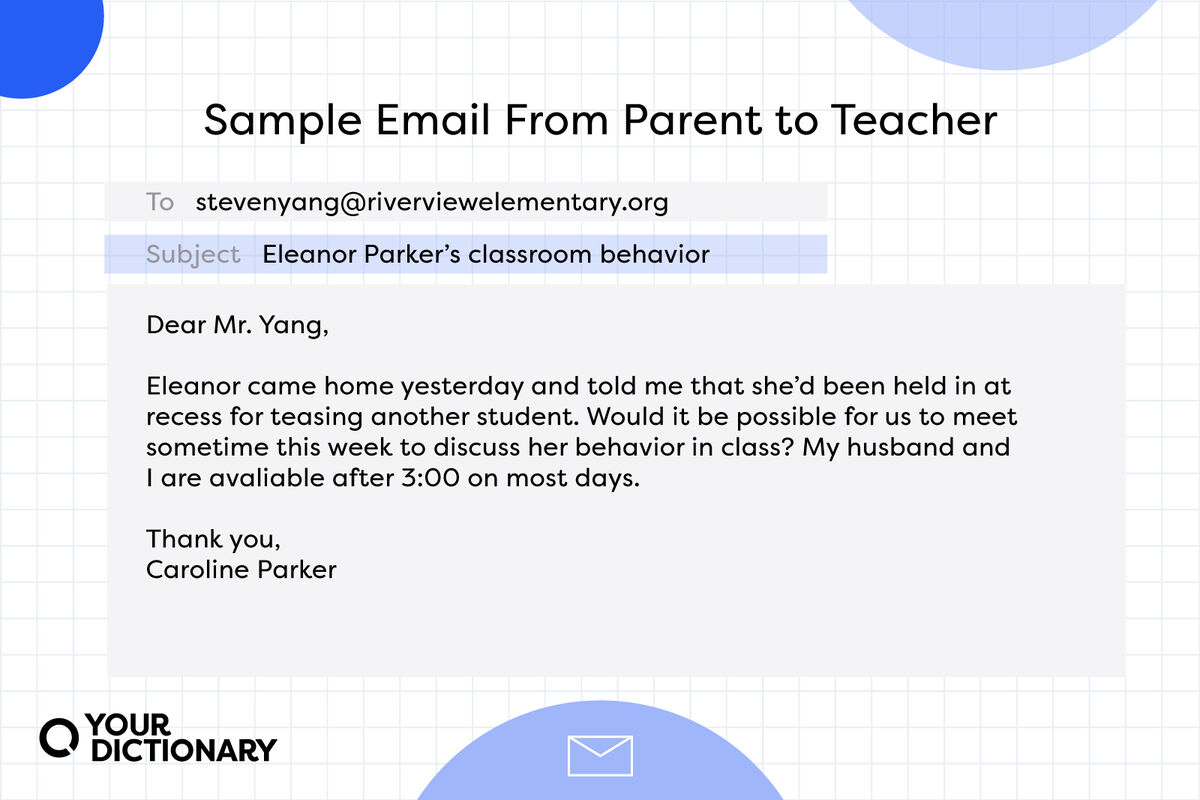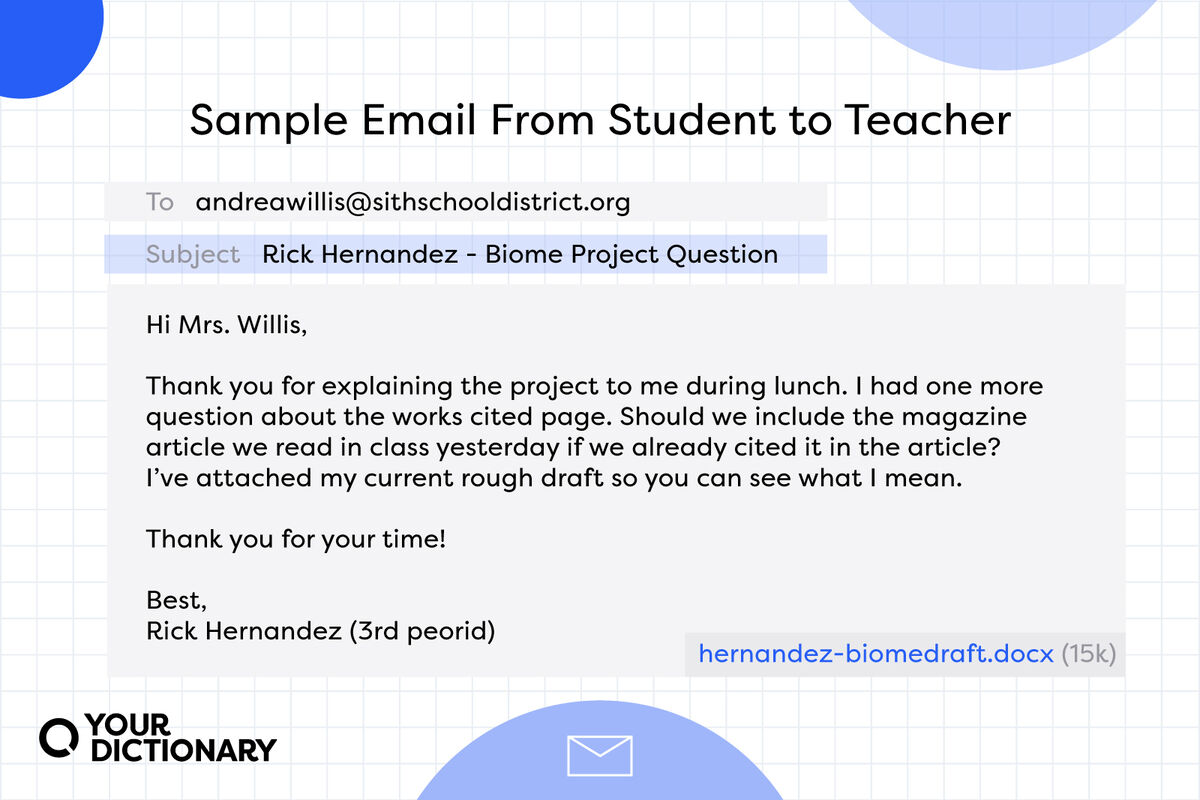
Whether you’ve got a quick question, need to submit your homework, or have a concern about your child’s class performance, writing an email to a teacher is an important skill. But what are the guidelines for writing an email to a teacher? Keep reading for instructions about writing clear, polite emails to teachers and professors.
How to Write an Email to a Teacher
There are several reasons why you might need to write an email to a teacher. If your goal is to have a question answered quickly, you’ll need to provide as much information as possible as concisely as possible. Follow these instructions to write a courteous email to your teacher and/or professor.
Use a Clear Subject Line
Teachers receive dozens of emails every day. That’s why a clear, detailed subject line will help a teacher understand exactly what your email is about, who it’s from and what the writer needs so you can get a timely answer. An email titled “Homework question” could be about anything and from anyone, but an email titled “Marie Kingsley - Question About Research Paper” helps a teacher immediately know who they’re talking to.
Choose the Correct Greeting
Open your email appropriately. If you’ve never met the teacher before, use “Dear Dr./Mr./Mrs./Ms. Last Name.” If you have met the teacher, you can use more conversational greetings like “Hi,” “Hello,” or “Good Morning.” Don’t use overly casual greetings like “Hey” or “What’s up,” and don’t refer to the teacher by their first name unless they have indicated that they’d prefer that you do so.
Structure as a Formal Letter
Formatting your email properly makes it more likely that you’ll get the answer you want. Use the same structure that you’d use for a formal letter, and avoid getting personal in the email. Avoid overly casual language, including slang or email abbreviations.
Include Only Necessary Information
Busy teachers don’t have time to read paragraphs of information just to answer a question or agree to write a letter of recommendation. Focus on exactly what you want to say and limit the length to 3-4 sentences maximum. Anything longer than that should probably be an in-person conversation.
Keep Your Tone Respectful
There’s a fine line between explaining yourself to a teacher and airing all your grievances. Teachers don’t need to hear how much you dislike an assignment or how unfair you feel a deadline is. Complaining to a teacher via email puts them on the defensive – and makes it unlikely that you’ll get the solution you want.
Use an Appropriate Salutation
The same rule for proper greetings applies to appropriate salutations. End an email to a teacher with “Thank you,” “Sincerely” or “Best,” followed by your full name. Avoid salutations such as “Thanks,” “See You Tomorrow” or no salutation at all. You want to leave the teacher with a good impression of you, even to the last word of your message.

Helpful Tips for Writing Polite Teacher Emails
Now that you know how to write a strong email to a teacher, you can improve your format and expectations. Try a few general tips to help you ensure that your email comes across well.
- Make sure you can’t find the information yourself. If you’re asking a question that you can easily answer by looking at the class syllabus or website, try that first. You may not need to write the email at all.
- Keep timing in mind. Teachers try to respond to emails within 24 hours. That said, if you email a teacher at 11 pm for an answer about an assignment due at 8 the next morning, they’re not going to get back to you in time. Don’t ask time-sensitive questions less than 24 hours before you’d like an answer.
- Write the email in a word document before sending it. This is a helpful tip for any formal email. Spare yourself the embarrassment (and your teacher the confusion) of sending a half-finished email before you’re ready to send it. Copy and paste your finished message once you’ve written what you want.
- Say thank you. Teachers are taking time out of their busy days to read and reply to your message. No matter what salutation you use, be sure to thank them for their time.
- Proofread spelling, grammar and tone. Writing a well-edited essay is a nice way to show teachers that you respect them. It also demonstrates how effective their teaching is. Double check any spelling mistakes, watch your grammar and keep the tone formal.
Additional Tips for Students
Writing an email to a teacher shows great student initiative. It gets them ready for life in the professional world, where clear and concise messages get prompt and helpful replies. Use some tips for students when writing an email to your teacher.
- If you can wait until class for the answer, then wait. Don’t waste your (or your teacher’s) time with a question that you can ask with a raised hand tomorrow.
- Attach all needed documents to the email. If you have specific questions about an assignment, attach or copy and paste necessary text into your email. It saves time and gives the teacher more information to answer your question.
- List all of the solutions you’ve already tried. Teachers might not have time to fully brainstorm your question. They might refer you to other sources of information instead. Let them know that you’ve already tried other solutions, and what you’ve already tried. That way, your teacher knows that you’re asking them as a last resort.
- Schedule time to talk. Longer or more complicated questions may require an in-person meeting. Rather than ask a complex question in an email, request to meet the teacher in their office hours, before or after school, or during lunch. Be sure to mention what the conversation is about so they can prepare. They’ll appreciate your initiative and will be more likely to give you a satisfactory response.
- Use your school email address (if you have one). Using your school email address is more professional than casual screen names or email addresses. It also allows you to keep teacher responses in one place.

Additional Tips for Parents
Sometimes parents need to contact a teacher on behalf of their children. These emails should also be polite and clear, and avoid being overly familiar. Check out these tips for parents writing an email to their child’s teacher.
- If the message can be handled by the student, let them write it. Young students need more help from their parents when reaching out to a teacher. Middle school, high school and college students – and even older elementary students – should be able to email their own teachers when needed. Parents can oversee and proofread these messages when needed, but letting students advocate for themselves is an important skill.
- Include your name and your student’s name. This is especially important if the teacher can’t identify you with your email address alone. Include your child’s name in the subject line, mention it throughout the email, and use your own name in the salutation.
- Determine whether the information would be better in a conference. Email isn’t a great forum for long discussions about student progress or behavior. If you have serious concerns about your child’s class performance, see if you can schedule an in-person or virtual conference rather than explaining the situation in an email.
- Consider CC’ing other recipients – or not. For situations that involve other staff members, such as school counselors, nurses or administrators, you might want to include more email addresses in your CC box. But for problems that involve other children, avoid writing emails that CC that child’s parents. Let the teacher decide how to involve both parties and resolve problems between students.
- Don’t expect an immediate response. Try not to send emails during the school day that ask about your child’s performance that day. Teachers rarely check emails during instructional time and are more likely to get back to you after school or during a break.
Writing Effective Emails
Email is a fast and easy way to communicate with a teacher. But just like any email, it’s important to be clear, polite, and concise to communicate effectively. Check out these additional tips for writing effective emails, including emails to friends, employers, colleagues, and hiring managers.